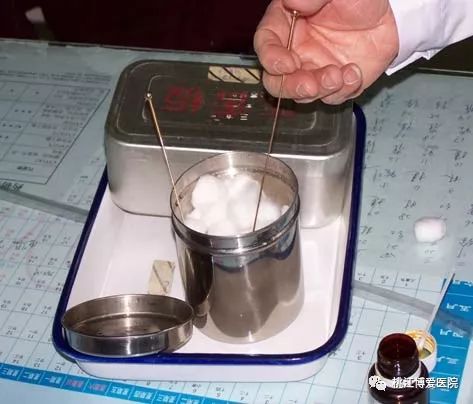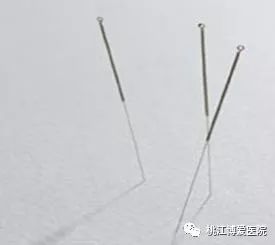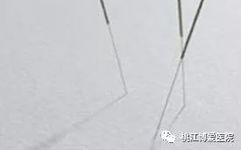 Fine Needle
Fine Needle

The fine needle is the most commonly used acupuncture tool in clinical practice, consisting of five parts: needle tip, needle body, needle root, needle handle, and needle tail. Due to its fine nature, it was historically referred to as “micro needle” or “small needle”. As recorded in the “Lingshu: Nine Needles and Twelve Origins”, it states: “The fine needle is sharp like a mosquito’s proboscis, used gently and slowly, lingering to nourish and relieve pain and numbness”; it is intended to open the meridians and regulate blood and qi. Later texts, such as the “Biao You Fu”, also noted that “among the nine needle techniques, the fine needle is the most delicate”, indicating that the fine needle, with its tip like a “mosquito’s proboscis” and slender body, can be used to puncture acupoints throughout the body, making it widely applicable.
The origin of the fine needle has a long history. The earliest acupuncture tool was the bian stone, which originated in the Neolithic era. Ancient texts such as the “Spring and Autumn Annals” and the “Book of Songs” record the use of stone tools for healing. Besides bian stones, ancient acupuncture tools included bone needles, bamboo needles, and ceramic needles. By the Western Zhou period, with advancements in metallurgy, bronze needles emerged, marking a significant leap in the development of acupuncture tools from stone to metal. By the Qin and Han dynasties, the “Huangdi Neijing” documented the nine needles, stating in the “Lingshu: Nine Needles and Twelve Origins”: “The nine needles have different shapes. The first is the chuan needle, the second is the round needle, the third is the sheng needle, the fourth is the feng needle, the fifth is the pi needle, the sixth is the round benefit needle, the seventh is the fine needle, the eighth is the long needle, and the ninth is the large needle”. The nine needles vary in length and thickness, used for treating various symptoms. Over time, the application of the fine needle has gradually expanded, as noted in the “Zhenjiu Zhai Ying Ji”: “The method resembles the fine tip… regulating the meridians to eliminate diseases”. The “Leijing Tuyu” states: “Sharp like a mosquito’s proboscis, it addresses cold and heat, and pain in the meridians”. The “Zhenjiu Dacheng” mentions: “For pain and cold, this needle is used”. The “Yizong Jinjian” states: “It must be sharp like a mosquito’s proboscis, taking its fine and gentle approach”. The fine needle has gradually become the main tool among the nine needles, with its application expanding until today, where it is a primary tool in clinical acupuncture. Currently, the most commonly used fine needle is made of stainless steel.
The development of fine needle acupuncture techniques has a long history. The “Huangdi Neijing” discusses and summarizes acupuncture techniques from ancient times, stating in the “Lingshu”: “If one cannot treat, it is due to not having mastered the technique”, highlighting the importance of acupuncture techniques. The “Neijing” mentions techniques such as “nine punctures”, “twelve punctures”, and “five punctures”, as well as methods for tonifying and reducing, including “gentle and rapid tonification and reduction”, “breath control for tonification and reduction”, “following and leading for tonification and reduction”, and “opening and closing for tonification and reduction”, laying the foundation for the development of acupuncture techniques in later generations. The “Nanjing” emphasizes the importance of hand coordination during acupuncture, valuing the claw-cutting method, effectively using following and leading for tonification and reduction, and utilizing the five elements’ generating and overcoming relationships for treatment. During the Jin and Yuan dynasties, the “Ziwuliuzhu” acupuncture method, represented by He Ruoyu, emerged, while Dou Hanqing was the first to use the through-needle flat puncture method. The Ming dynasty was a period of flourishing acupuncture techniques, with Xu Feng’s “Zhenjiu Daqian” establishing twelve comprehensive and complex techniques, such as “burning mountain fire” and “piercing sky coolness”, and Wang Ji’s “Zhenjiu Wendu” also detailing various acupuncture techniques.
Indications for fine needle acupuncture: In 1979, the World Health Organization (WHO) proposed and recommended the global promotion of acupuncture for 43 conditions. In 2002, this list was updated to 4 categories of 107 conditions. Recent studies by Chinese scholars on acupuncture disease spectra indicate that acupuncture can be effective for 16 categories of 461 conditions.
Currently, fine needle acupuncture is widely used clinically for:
Neurological and psychiatric conditions: stroke, migraine, trigeminal neuralgia, sciatica, peripheral facial nerve paralysis, neurasthenia, hysteria, epilepsy, intercostal neuralgia, schizophrenia, traumatic paraplegia, brachial plexus pain, peripheral nerve injury, etc.
Respiratory conditions: bronchial asthma, acute and chronic bronchitis, upper respiratory tract infections, acute tonsillitis, etc.
Digestive conditions: gastric ptosis, peptic ulcers, chronic diarrhea, acute and chronic gastritis, neurogenic vomiting, chronic constipation, gastrointestinal neurosis, diaphragm spasm, chronic enteritis, etc.
Gynecological conditions: dysmenorrhea, irregular menstruation, premenstrual syndrome, functional uterine bleeding, infertility, premature ovarian failure, perimenopausal syndrome, etc.
Circulatory conditions: hypertension, coronary heart disease, arrhythmia, cardiac neurosis, etc.
Dermatological conditions: urticaria, herpes zoster, neurodermatitis, etc.
Endocrine conditions: simple goiter, type 2 diabetes, hyperthyroidism, etc.
Musculoskeletal and connective tissue conditions: cervical spondylosis, rheumatoid arthritis, periarthritis of the shoulder, lower back pain, rheumatic arthritis, osteoarthritis, acute lumbar sprain, etc.
Otorhinolaryngological conditions: chronic rhinitis, pharyngitis, conjunctivitis, epistaxis, toothache, neurogenic deafness, neurogenic tinnitus, ear-related vertigo, optic nerve atrophy, etc.
Urogenital conditions: impotence, prostatitis, urinary incontinence, urinary retention, etc.
Pediatric conditions: pediatric anorexia, pediatric enuresis, post-polio syndrome, etc.
Contraindications for fine needle acupuncture: 1. Patients who are hungry, overfull, intoxicated, angry, frightened, fatigued, or mentally tense should not undergo fine needle acupuncture treatment; 2. Patients with weak constitution or deficiency of qi and blood should not receive strong needle sensations; they should be treated in a supine position to avoid fainting; 3. Important organ areas, such as the hypochondriac region, back, kidney area, and liver area, should not be punctured directly or deeply; 4. For acupoints located near major blood vessels or subcutaneous veins, if acupuncture is necessary, the needle should be inserted obliquely to avoid blood vessels; 5. Acupuncture is prohibited on the top of the head in children with open fontanelles; 6. In pregnant women, acupuncture is prohibited in the lower abdomen, lumbar region, perineum, and acupoints that may produce strong sensations or are sensitive to pregnancy (such as Hegu (LI4), Zusanli (ST36), Fengchi (GB20), Huantiao (GB30), Sanyinjiao (SP6), Xuehai (SP10), Zhiyin (BL67), etc.); 7. Patients with severe allergic, infectious skin diseases, skin ulcers, or skin tumors should not be punctured directly at the affected area; 8. Patients with coagulation disorders are prohibited from acupuncture; 9. For children, during tetanus, during seizures, or during manic episodes of schizophrenia, acupuncture should not be retained.
Precautions for fine needle acupuncture: During fine needle acupuncture treatment, due to insufficient psychological preparation of the patient and other reasons, the following abnormal situations may occur and should be handled promptly.
1. Needle fainting: Needle fainting is a common abnormal situation during acupuncture treatment. If the patient suddenly experiences dizziness, nausea, palpitations, pale complexion, cold sweat, etc., during acupuncture or while retaining needles, acupuncture should be immediately stopped, all retained needles should be removed, and the patient should be laid flat, eyes closed, and allowed to rest, with a small amount of warm water to drink, and the surrounding environment should be kept quiet. If symptoms are severe, acupuncture points such as Ren Zhong (GV26), Nei Guan (PC6), and Zu San Li (ST36) can be needled to promote recovery. If the above methods do not work and the patient shows weak heartbeat, weak breathing, and thin pulse, appropriate emergency measures should be taken. To prevent needle fainting, the practitioner should first explain the effects of acupuncture therapy and possible sensations to the patient, alleviating their fears. For those who are overly hungry or have a very weak constitution, they should drink a small amount of water before acupuncture; for those who have just engaged in heavy physical labor, they should be allowed to rest for a moment before acupuncture.
2. Stuck needle: During needle insertion and removal, the practitioner may feel a sense of resistance, pulling, or wrapping around the needle body at the acupoint, and sometimes the patient may feel severe pain, referred to as stuck needle. When stuck needle occurs, do not forcibly insert or remove the needle. The patient should be instructed to relax, and the practitioner should massage the acupuncture site to relax the local muscles. Then, the practitioner should gently twist the needle in the opposite direction of the initial insertion, lift the needle body, and slowly remove the needle. To prevent stuck needle, the practitioner should explain the procedure to the patient beforehand to avoid tension during acupuncture. If local muscle contraction causes positional movement during acupuncture, the practitioner can massage the acupuncture site to slowly help the patient return to the original position, gently twist the needle body to remove it, and not retain the needle.
3. Bent needle: A bent needle occurs when the needle body bends under the skin or outside the skin. Bent needles outside the skin are often caused by the needle being pressed or twisted by other objects while retained. To prevent bent needles, the practitioner should ensure the patient is in a comfortable position and fully relaxed before acupuncture. During needle retention, the needle handle should not be covered with heavy clothing, should not be bumped, and the patient should not change position or rotate their limbs.
4. Broken needle: A broken needle occurs when part or all of the needle breaks off at the acupuncture site, also known as a fractured needle. Common causes include rust at the needle root causing breakage during acupuncture. Another cause is improper handling of stuck or bent needles or forcibly removing the needle, resulting in part of the needle breaking off in the subcutaneous or muscle tissue. In this case, the patient should be instructed to relax and not move. For subcutaneous broken needles, the practitioner can use their left thumb and index finger to apply vertical pressure on the soft tissue next to the needle hole to help the broken needle end exit the hole, and use tweezers in the right hand to grasp the broken needle end and remove it. If the needle breaks at a deeper location, X-ray localization and surgical removal may be necessary. To prevent broken needles, practitioners should carefully inspect the needles before acupuncture, discarding any with loose handles, rust at the needle root, or those that have previously been bent. When stuck or bent needles occur, practitioners should handle them promptly and correctly.
5. Bleeding and hematoma: After needle removal, bleeding or subcutaneous hematoma may occur at the acupuncture site. If bleeding or hematoma occurs, a disinfected cotton ball should be held against the bleeding point or hematoma. If bleeding stops or the hematoma does not increase, no further treatment is needed, and the local skin discoloration will gradually fade. If the above pressure does not stop the bleeding and the hematoma continues to enlarge, increase the pressure and area of application, and apply cold compresses, then apply pressure bandaging. After 48 hours, switch to warm compresses to dissipate the bruise. To prevent bleeding and hematoma, practitioners should carefully inspect the needles before acupuncture, and during acupuncture, pay attention to the course of subcutaneous blood vessels, avoiding puncturing them. During acupuncture, patients should not change positions casually. For consultation, please contact WeChat: 18975372388


